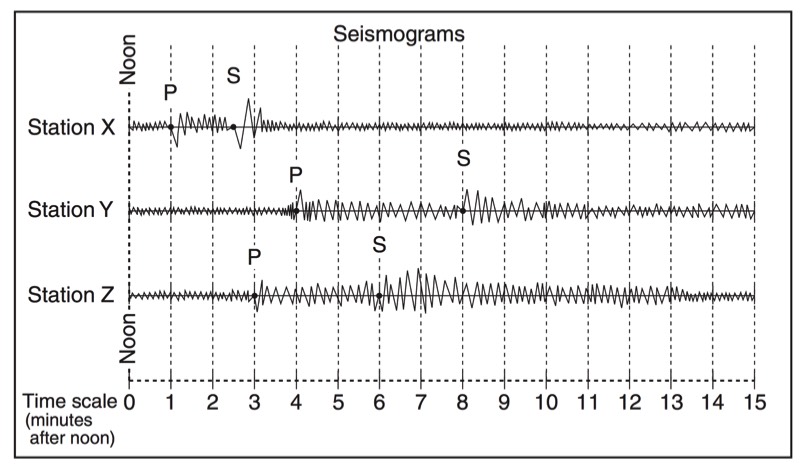What is the name of the oceanic tectonic plate located along the west coast of South America?
Pacific Plate.
What's the difference between lava and magma?
Lava is the term for molten rock outside of a volcano, magma is the term for it being inside the volcano.
How do you find the time of origin of an earthquake?
Subtract the P-Wave arrival and P-Wave travel time.
A huge undersea earthquake off the Alaskan coastline could produce a?
1) tsunami
2) cyclone
3) hurricane
4) thunderstorm
1) tsunami.
Why are P-waves received, but S-waves are not received by seismic stations located on the opposite side of Earth from an earthquake epicenter?
(1) S-waves travel slower than P-waves.
(2) S-waves travel faster than P-waves.
(3) Earth’s inner core absorbs S-waves.
(4) Earth’s outer core absorbs S-waves.
(4) Earth’s outer core absorbs S-waves.
Identify the names of the two tectonic plates that are located near Alaska.
Pacific Plate, North American Plate.
Recent volcanic activity in different parts of the world supports the inference that volcanoes are located mainly in?
1) the central regions of continents
2) zones of crustal activity
3) zones in late stages of erosion
4) the centers of landscape regions
2) zones of crustal activity.
If it takes a P-wave five minutes to travel from the epicenter of an earthquake to a seismic station, approximately how long will it take an S-wave to travel that same distance?
(1) 15 minutes
(3) 9 minutes
(2) 12 minutes
(4) 4 minutes
(3) 9 minutes
Where are earthquakes most likely to take place?
1) along the core-mantle interface
2) where the composition of the Earth tends to be uniform
3) near the Earth's Equator
4) near a fault zone
4) near a fault zone.
Which statement correctly compares seismic P-waves with seismic S-waves?
1) P-waves travel faster than S-waves and pass through Earth’s liquid zones.
2) P-waves travel faster than S-waves and do not pass through Earth’s liquid zones.
3) P-waves travel slower than S-waves and pass through Earth’s liquid zones.
4) P-waves travel slower than S-waves and do not pass through Earth’s liquid zones
1) P-waves travel faster than S-waves and pass through Earth’s liquid zones.
Which mantle hot spot is correctly matched to its overlying tectonic plate?
(1) Tasman Hot Spot–Pacific Plate
(2) Canary Island Hot Spot–Eurasian Plate
(3) St. Helena Hot Spot–South American Plate
(4) Yellowstone Hot Spot–North American Plate
(4) Yellowstone Hot Spot–North American Plate.
What are the 3 main types of volcanoes?
Shield, Cone, and Stratovolcano.
What does the difference of p-waves and s-waves arrival times suggest about the relative locations of seismographs?
The closer together the waves, the closer you are, and the farther away, the farther away you are.
The time that an earthquake occurs can be inferred by knowing the?
1) distances between seismograph stations
2) epicenter distance and arrival time of the P-waves
3) travel time of the S-waves
4) arrival time of P-waves
2) epicenter distance and arrival time of the P-waves.
The study of how seismic waves change as they travel through Earth has revealed that?
1) P-waves travel more slowly than S-waves through Earth’s crust
2) seismic waves travel more slowly through the mantle because it is very dense
3) Earth’s outer core is solid because P-waves are not transmitted through this layer
4) Earth’s outer core is liquid because S-waves are not transmitted through this layer
4) Earth’s outer core is liquid because S-waves are not transmitted through this layer.
Identify 2 plates that have a transform boundary.
African Plate and Antarctic Plate, Indian-Australian Plate and Pacific Plate, Pacific Plate and North American Plate, Scotia Plate and Antarctic Plate, Scotia Plate and South American Plate, and Caribbean Plate and North American Plate.
Where are most of the active volcanoes in the world found?
The Ring of Fire.
When did the P-Waves arrive for each seismograph?

12:01, 12:05, 12:03
The inference that the inner core of the Earth is solid is based on analysis of?
1) seismic data
2) crustal rock
3) radioactive data
4) meteorite composition
1) seismic data.
How long would it take for the first S-wave to arrive at a seismic station 4,000 kilometers away from the epicenter of an earthquake?
1) 5 min 40 sec
2) 7 min 0 sec
3) 12 min 40 sec
4) 13 min 20 sec
3) 12 min 40 sec.
The presence of marine fossils at elevations high above sea level provides good evidence for?
1) volcanic eruptions
2) crustal erosion
3) continental glaciation
4) crustal uplift
4) crustal uplift.
Which of the Hawaiian Islands has the greatest probability of having a volcanic eruption?
1) Oahu
2) Hawaii
3) Kauai
4) Maui
2) Hawaii.
Which seismograph recorded the earliest P-wave arrival? The latest? 
Station X, Station Y
How does the Mercalli and Richter Scale differ?
The Mercalli scale describes the intensity of an earthquake based on its observed effects, the Richter scale describes the earthquake's magnitude by measuring the seismic waves that cause the earthquake.
The epicenter of an earthquake is 6,000 kilometers from an observation point. What is the difference in travel time for the P-waves and S-waves?
1) 7 min 35 sec
2) 9 min 20 sec
3) 13 min 10 sec
4) 17 min 00 sec
1) 7 min 35 sec.